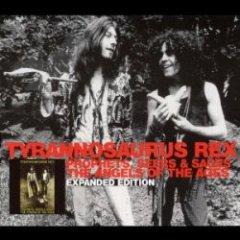Tyrannosaurus Rex - Prophets, Seers & Sages: The Angels Of The Ages (1968)
Tyrannosaurus Rex - Prophets, Seers & Sages: The Angels Of The Ages (1968)

01. Deboraarobed – 3:31 02. Stacey Grove – 1:56 03. Wind Quartets – 2:54 04. Conesuala – 2:22 05. Trelawny Lawn – 1:44 play 06. Aznageel The Mage – 1:56 07. The Friends – 1:16 08. Salamanda Palaganda – 2:12 09. Our Wonderful Brownskin Man – 0:48 10. O Harley (The Saltimbaques) – 2:17 11. Eastern Spell – 1:38 play 12. The Travelling Tragition – 1:45 13. Juniper Suction – 1:10 14. Scenescof Dynasty – 4:06 - Marc Bolan - vocals, guitar - Steve "Peregrine" Took - bongos, vocals, African drums, kazoo, pixiephone, Chinese gong
The most underrated of Tyrannosaurus Rex's four albums, Prophets, Seers & Sages was recorded just six months after their debut and adds little to the landscapes which that set mapped out. There is the same reliance on the jarring juxtaposition of rock rhythms in a folky discipline; the same abundance of obscure, private mythologies; the same skewed look at the latest studio dynamics, fed through the convoluted wringer of the duo's imagination -- the already classic pop of the opening "Deboraarobed" is further dignified by its segue into the same performance played backwards, a fairly groundbreaking move at a time when even the Beatles were still burying such experiments deep in the mix. But if the album itself found the duo rooted to the musical spot, still it delivered some of Marc Bolan's most resonant songs. The nostalgia-flavored "Stacey Grove" and the contrarily high-energy "Conesuela" were as peerless as any of Bolan's more feted compositions. Equally intriguing is the confidence which exudes from "Scenes of Dynasty," a successor of sorts to the last album's "Scenesof," but presented with just percussion and some strange vocal noises to accompany Bolan's singing -- at a time when "singing" was maybe not the term a lot of listeners would employ for his vocals. The excited "one-two-three-four" count-in only adds to the dislocation, of course. Finally, the owlishly contagious "Salamanda Palaganda" offers a first-hand peek into the very mechanics of Bolan's songwriting. Other composers stuck for a rhyme either reach for the thesaurus or abandon the lyric altogether. Bolan simply made one up, and in the process created a whole new language -- half nonsense, half mystery, but wholly intoxicating. Just like the rest of the album, in fact. ---DaveThompson, allmusic.com
download (mp3 @320 kbs):
yandex mediafire ulozto gett bayfiles
Last Updated (Tuesday, 29 January 2019 21:24)
